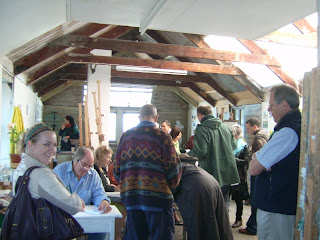Kurt Jackson's latest exhibition, The Tamar - Dowr Tamer, opened at Lemon Street Gallery, Truro on the 6th of September.  It follows the river Tamar from source to sea through all of the seasons. Works include vast mixed media canvases, intimate pencil sketches, sculptures and three-dimensional pieces.
It follows the river Tamar from source to sea through all of the seasons. Works include vast mixed media canvases, intimate pencil sketches, sculptures and three-dimensional pieces.My favourite piece was the extremely evocative Tamarstone Wood (above right) 100 x 100cm Acrylic, ink, oil, wood and twigs £10,500
I am always taken by Kurt's collections such as Source Box, (left), 17 x 10 x 13cm, found objects and pencil, £850. There were few of Kurt's signature seascapes in this show but the tidal reaches proved a rich source of inspiration. St John's Lake, June 2007, (right), 57 x 59cm, mixed media.
 My particular favourites are the playful Pony and Rocking horse from Michal Silhan. The elegant, simple, shapes of these forms belies the technilogical challenges involved in their casting. The way in which they are placed allows the pieces to interact with each other and for new shapes to be formed between them.
My particular favourites are the playful Pony and Rocking horse from Michal Silhan. The elegant, simple, shapes of these forms belies the technilogical challenges involved in their casting. The way in which they are placed allows the pieces to interact with each other and for new shapes to be formed between them. Pillow and Lowair from Zuzana Kynclova are equally playful but quite different. The subtleties of the contours and the density of colours make these pieces highly tactile. Visually these pieces entice the viewer to believe that they will be soft and yielding even though they know that they are formed from cold, hard, glass.
Pillow and Lowair from Zuzana Kynclova are equally playful but quite different. The subtleties of the contours and the density of colours make these pieces highly tactile. Visually these pieces entice the viewer to believe that they will be soft and yielding even though they know that they are formed from cold, hard, glass. Veronica Cerna is showing two blown and cut glass vases, reminiscent of dividing cells, the depths of which harbour rich fluid colours that draw the viewer inwards.
Veronica Cerna is showing two blown and cut glass vases, reminiscent of dividing cells, the depths of which harbour rich fluid colours that draw the viewer inwards.





 Peter Freeman
Peter Freeman







.JPG)








.JPG)



